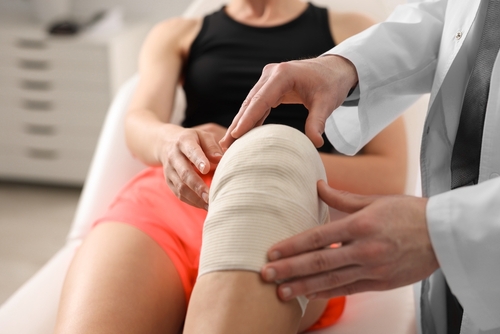Understanding Sports Injuries: Causes, Types, and Treatment Options
In Charlotte, NC, a sports injury can occur in various forms and impact athletes of all ages and skill levels. Understanding these injuries, including activity-related injuries, is crucial for effective prevention and treatment. They generally fall into two categories: acute and chronic.
Acute injuries happen suddenly during activity. They can result from falls, collisions, or improper movements. Examples include fractures, sprains, and strains. On the other hand, chronic injuries develop over time due to repetitive stress on muscles and joints. Conditions like tendinitis and bursitis are common in this category.
Recognizing the signs and symptoms of these injuries is essential for timely intervention. Early diagnosis can lead to more effective treatment and a quicker return to activity. Addressing minor injuries promptly is important to prevent them from escalating into more significant issues. Whether you are a professional athlete or a weekend warrior, knowing how to identify and address sports injuries can help you maintain an active lifestyle and prevent further complications.
At Apex Orthopaedics Spine & Neurology, our team of sports medicine professionals is dedicated to providing comprehensive care for all types of sports injuries. We focus on tailored treatment plans that promote faster recovery and less pain, ensuring you can get back to doing what you love.
What Are Sports Injuries?
Sports injuries refer to physical harm that occurs during athletic activities, whether recreational or competitive. These injuries can affect anyone, from professional athletes to weekend warriors. Understanding the nature of sports injuries is crucial for effective prevention and treatment.
Acute vs. Chronic Sports Injuries
Sports injuries can generally be categorized into two types: acute and chronic.
Acute injuries occur suddenly during physical activity. They often result from a specific incident, such as a fall, collision, or awkward landing. Common examples include fractures, sprains, and strains. These injuries typically cause immediate pain and swelling, requiring prompt medical attention.
On the other hand, chronic injuries develop gradually over time, often due to repetitive stress on certain body parts. Athletes may experience these injuries after prolonged training or competition without adequate rest. Conditions like tendinitis and stress fractures fall into this category. Chronic injuries may not show symptoms right away, making early diagnosis and intervention essential for effective treatment.
Recognizing the difference between acute and chronic sports injuries helps athletes and coaches implement appropriate prevention strategies and seek timely medical care. By understanding the causes and types of sports injuries, athletes can better protect themselves and enhance their performance.
Common Types of Sports Injuries
Sports injuries can vary widely in type and severity. Understanding these injuries is crucial for athletes and active individuals alike. Here, we’ll explore some of the most common musculoskeletal injuries that athletes face, as well as specific injuries related to particular sports.
Musculoskeletal Injuries in Athletes
Fractures and Dislocations
Fractures occur when a bone breaks due to high impact or stress. Dislocations happen when the bones in a joint become displaced. Both injuries can result from falls, collisions, or awkward landings. Immediate medical attention is necessary to properly diagnose and treat these injuries.
Sprains and Strains
Sprains involve the stretching or tearing of ligaments, while strains, such as muscle strain, affect muscles or tendons. These injuries often occur during sports activities that require sudden changes in direction or heavy lifting. Treatment typically includes rest, ice, compression, and elevation (RICE), along with physical therapy for rehabilitation.
Tendinitis and Bursitis
Tendinitis is the inflammation of a tendon, often caused by repetitive motion or overuse. Bursitis involves the inflammation of the bursa, a small fluid-filled sac that cushions joints. Both conditions can lead to significant pain and hinder performance. Treatment options may include rest, anti-inflammatory medications, and targeted physical therapy.
Specific Sports Injuries
Shoulder Injuries: Rotator Cuff and Impingement
Shoulder injuries, such as rotator cuff tears and impingement syndrome, are common among athletes involved in throwing or overhead activities. These injuries can limit range of motion and cause pain. Early diagnosis and rehabilitation are essential for recovery.
Elbow Injuries: Tennis Elbow and Golfer’s Elbow
Tennis elbow (lateral epicondylitis) and golfer’s elbow (medial epicondylitis) are overuse injuries affecting the tendons around the elbow. These injuries result from repetitive motions associated with racquet sports or golf. Treatment often involves rest, physical therapy, and, in some cases, corticosteroid injections.
Knee Injuries: ACL Tears and Meniscal Tears
Knee injuries, such as anterior cruciate ligament (ACL) tears and meniscal tears, are prevalent in sports that involve sudden stops or changes in direction. These injuries can be severe and may require surgical intervention for proper healing. Rehabilitation is crucial for a successful return to sports.
Ankle Injuries: Sprains and Achilles Tendinitis
Ankle sprains are among the most common sports injuries, often resulting from awkward landings or rolling the ankle. Achilles tendinitis, characterized by pain along the back of the ankle and involving the Achilles tendon, is common among runners. Both conditions necessitate careful management and rehabilitation to prevent long-term issues.
Understanding these common types of sports injuries can help athletes recognize symptoms early and seek appropriate treatment. With the right approach, recovery can be swift, allowing athletes to return to their active lifestyles.
Who Is at Risk for Sports Injuries?
Factors Increasing the Risk of Sports Injuries
Sports injuries can affect anyone, but certain factors can heighten the risk. Understanding these factors is crucial for athletes, coaches, and parents alike.
- Age and Experience: Younger athletes may lack the physical maturity and experience needed to prevent injuries. Conversely, older athletes might face increased risks due to age-related changes in their bodies.
- Type of Sport: Contact sports, such as football and hockey, often lead to more severe injuries compared to non-contact sports like swimming or cycling. Each sport has its own set of risks based on the physical demands involved.
- Training Regimen: Insufficient training or improper techniques can lead to acute injuries. Overtraining, on the other hand, can contribute to chronic injuries. Athletes should follow structured training programs to minimize these risks.
- Physical Condition: An athlete’s overall fitness level plays a significant role in injury prevention. Those with poor body composition, muscle strength, or flexibility are more susceptible to injuries. Regular conditioning and strength training can help mitigate these risks.
- Previous Injuries: A history of injuries can increase the likelihood of re-injury. Athletes should take extra precautions and follow rehabilitation protocols to strengthen vulnerable areas.
- Equipment and Environment: Using the right gear, such as supportive footwear or protective pads, is essential. Additionally, playing surfaces should be well-maintained to reduce the risk of slips, trips, and falls.
- Weather Conditions: Extreme temperatures can affect performance and increase the risk of heat-related illnesses or injuries. Athletes should stay hydrated and take breaks during intense weather conditions.
By recognizing these risk factors, athletes and coaches can take proactive steps to prevent injuries. Implementing proper training techniques, maintaining good physical condition, and using appropriate equipment are essential strategies for minimizing the risk of sports injuries.
The Importance of Sports Medicine
Sports medicine, particularly orthopaedic sports medicine, plays a crucial role in the treatment and prevention of injuries sustained during athletic activities. It focuses on helping athletes recover from injuries while also providing strategies to avoid future incidents. Sports medicine doctors and providers specialize in diagnosing and treating a wide range of sports-related conditions, ensuring that athletes can return to their active lifestyles as quickly and safely as possible.
These professionals are trained to understand the unique demands placed on the body by different sports. They assess injuries, develop personalized treatment plans, and guide athletes through rehabilitation. This comprehensive approach not only addresses immediate injuries but also emphasizes long-term health and performance enhancement.
In addition to treating injuries, sports medicine specialists collaborate with physical therapists and athletic trainers to create tailored fitness programs. These programs focus on strength, flexibility, and endurance, which are essential for preventing injuries. By understanding the biomechanics of each sport, they help athletes optimize their performance while minimizing risks.
Ultimately, the expertise of sports medicine providers is invaluable for anyone involved in athletics, from amateur enthusiasts to professional competitors. Their knowledge and support can significantly impact recovery times and overall athletic performance, making them an essential part of any athlete’s healthcare team.
Treatment and Rehabilitation for Sports Injuries
When dealing with sports injuries, timely and effective treatment is crucial for a successful recovery. Athletes and active individuals often face various injuries, ranging from minor strains to severe fractures. Understanding the appropriate treatment options can significantly impact recovery time and overall performance.
Non-Surgical Treatment Options
For many sports injuries, non-surgical approaches are often the first line of defense. These methods focus on alleviating pain and promoting healing without the need for invasive procedures. Common non-surgical treatments include:
- Physical Therapy: Tailored rehabilitation programs designed by physical therapists help restore strength, flexibility, and function. These programs often include exercises that focus on specific muscle groups affected by the injury.
- Rest and Activity Modification: Allowing the injured area to heal is essential. Athletes may need to temporarily adjust their training routines or take time off from their sport to prevent further damage.
- Ice and Compression: Applying ice can reduce swelling and pain. Compression bandages help support the injured area, minimizing discomfort during movement.
- Medication: Over-the-counter pain relievers can be effective in managing pain and inflammation. In some cases, prescription medications may be necessary for more severe pain.
- Injections: Corticosteroid injections may be used to reduce inflammation in chronic injuries, providing temporary relief and enabling athletes to resume activity.
When Is Orthopaedic Surgery Necessary?
In some instances, sports injuries may require surgical intervention. Surgery is typically considered when:
- Severe Injuries: Fractures or dislocations that cannot be treated effectively through non-surgical means may necessitate surgical repair.
- Persistent Pain: If non-surgical treatments fail to alleviate pain or restore function, surgery may be the best option.
- Structural Damage: Injuries that result in significant damage to ligaments, tendons, or cartilage often require surgical reconstruction to restore stability and function.
- Long-Term Recovery Goals: Athletes aiming to return to high-level competition may need surgical options to ensure a full recovery and minimize the risk of re-injury.
At Apex Orthopaedics Spine & Neurology, our team of experts evaluates each injury thoroughly. We develop a comprehensive treatment plan tailored to your specific needs, ensuring you receive the best care possible. Whether you require non-surgical options or surgical intervention, we are committed to helping you recover effectively and return to your active lifestyle.
Why Choose Apex Orthopaedics Spine & Neurology for Your Sports Injury?
When it comes to sports injuries, choosing the right provider can make all the difference in your recovery. At Apex Orthopaedics Spine & Neurology, we understand the unique challenges athletes face. Our dedicated team is committed to delivering exceptional care tailored to your specific needs.
Our Expert Sports Medicine Team
Our sports medicine team consists of experienced professionals, including orthopaedic surgeons and neurology specialists. This diverse expertise allows us to address various aspects of your injury. Whether you’re dealing with a minor strain or a significant fracture, our specialists collaborate to create a comprehensive treatment plan. Additionally, our physical therapists and athletic trainers work closely with you to enhance your rehabilitation process. They focus on restoring your strength and mobility, ensuring you can return to your sport as quickly and safely as possible.
Our Approach to Sports Injury Care
At Apex Orthopaedics, we prioritize patient comfort and accessibility. We offer no out-of-pocket expenses for those who qualify, making it easier for you to focus on recovery. Our same and next-day appointments mean you won’t have to wait long to receive the care you need. For added convenience, we also provide telemedicine visits, allowing you to consult with our specialists from the comfort of your home.
Choosing Apex Orthopaedics Spine & Neurology means choosing a team that is dedicated to your health and performance. We are here to help you regain your strength and get back to doing what you love. Don’t let a sports injury hold you back; contact us today for the expert care you deserve.
Preventing Sports Injuries: Tips for an Active Lifestyle
Preventing sports injuries is crucial for maintaining an active lifestyle. Athletes of all ages can benefit from understanding how to reduce the risk of injuries. Here are some essential tips to help you stay safe while enjoying your favorite sports.
Warm-Up and Cool Down
Always begin with a proper warm-up before engaging in any physical activity. This helps prepare your muscles and joints for the demands of your sport. Similarly, cooling down after exercise aids in recovery and reduces muscle soreness.
Use Proper Equipment
Wearing the right gear is vital. This includes supportive footwear, helmets, and other protective equipment specific to your sport. Ensure that all gear fits well and is in good condition to provide maximum protection.
Gradual Training
Avoid sudden increases in intensity or duration of your training. Gradually build up your activity levels to allow your body to adapt. This approach helps prevent overuse injuries and reduces the risk of strains and sprains.
Listen to Your Body
Pay attention to any signs of discomfort or pain. Ignoring these signals can lead to more severe injuries. If you experience persistent pain, consult a sports medicine professional for guidance.
Stay Hydrated and Maintain Nutrition
Proper hydration and nutrition play a significant role in injury prevention. Staying hydrated helps maintain muscle function, while a balanced diet supports overall health and recovery.
Incorporate Strength and Flexibility Training
Engaging in strength training and flexibility exercises can improve your overall athletic performance. Stronger muscles and flexible joints are less prone to injuries. Consider working with a physical therapist or athletic trainer to develop a personalized program.
Cross-Training
Incorporate different types of physical activities into your routine. Cross-training helps to balance muscle development and reduces the risk of overuse injuries from repetitive movements in a single sport.
By following these guidelines, you can significantly reduce your risk of sports injuries. Prioritizing prevention allows you to enjoy your activities while keeping your body healthy and strong. For more personalized advice, reach out to our sports medicine team at Apex Orthopaedics Spine & Neurology.
When to Seek Care for a Sports Injury
Knowing when to seek medical care for a sports injury is crucial for preventing further damage and ensuring proper healing. If you experience severe pain, swelling, or numbness following an injury, it is essential to seek immediate medical attention. Our orthopaedic urgent care clinic is open seven days a week, providing fast and convenient care for acute injuries. Even if you are unsure about the severity of your injury, it is always better to err on the side of caution and consult a medical professional. Early treatment can significantly impact your recovery, helping you return to your active lifestyle more quickly and safely.
Contact Us Today for Faster Recovery and Less Pain
If you are dealing with a sports injury, reaching out to Apex Orthopaedics Spine & Neurology is a critical step towards your recovery. Our dedicated team is here to provide you with the medical care you need. We understand that injuries can disrupt your active lifestyle and lead to frustration. That’s why we offer a streamlined process to help you get back on your feet as quickly as possible.
Schedule Your Appointment with Apex Orthopaedics Spine & Neurology
We prioritize your health and convenience. Our clinic offers same and next-day appointments, ensuring you receive timely care without long waits. Whether you prefer in-person visits or telemedicine consultations, we accommodate your needs.
Our sports medicine team, which includes experienced orthopaedic surgeons, physical therapists, and athletic trainers, works collaboratively to develop a treatment plan tailored to your specific injury. We focus on providing effective rehabilitation strategies to promote faster recovery and reduce pain.
Don’t let a sports injury hold you back. Contact us today to schedule your appointment and take the first step towards regaining your strength and returning to the activities you love. Your recovery journey starts here 704-412-3045






